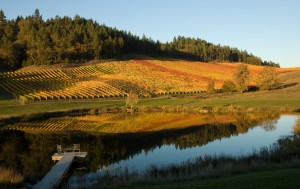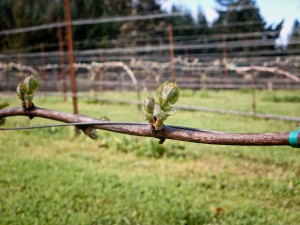Field grafting aka How to dodge the heat from Hollywood


The south-facing slopes of Reustle-Prayer Rock Vineyards’ Romancing Rock Vineyard is planted with a multitude of varietals including riesling, pinot gris, semillon, grüner veltliner, pinot noir, sauvignon blanc, grenache, grüner veltliner, syrah noir, tempranillo, merlot, roussanne, viognier and syrah. Photo courtesy of Reustle-Prayer Rock Vineyards.
For anyone who’s ever seen Sideways and wondered how wineries might have dealt with the fall out of merlot, allow me to introduce you to field grafting.
Stephen Reustle, owner, winemaker and viticulturist of Reustle-Prayer Rock Vineyards located in Roseburg, Oregon, took some time to explain this fascinating vineyard practice.
There are a few different reasons for field grafting and one nods to a certain 2004 movie. A winemaker might plant root stock with no decision regarding varietals and clones and field graft the appropriate scion wood (vine typically containing two buds) to the root stock the following year or correct a vineyard error like cabernet sauvignon planted in a cool vineyard location that’s not reaching adequate heat units by grafting over to pinot noir or pinot gris, as Reustle explained it, or as prices fluctuate a vineyard may have a great deal of one grape planted “and after a certain movie came out merlot takes a hit and vineyard owners cut off merlot and regraft to pinot noir, for example.”

Another reason for grafting over is in the case of not knowing when bud break is. If a varietal sensitive to frost is planted in a “little hollow” of a vineyard, the winemaker might regraft with one that breaks bud two-three weeks later like this syrah bud. Photo courtesy of Reustle-Prayer Rock Vineyards.
Grafting over is typically performed between late March through April and down time is not impacted by varietal. A successful graft over is generally defined by a 90 percent ‘take’ rate with no fruit expected that year.
Reustle said “Next year should (yield) 30 percent of a typical harvest. The following year, look toward full harvest.”
He went on to describe the most common type of field grafting—cleft grafting, using mature vines. The vine is cut off, a cold chisel is used to hammer the vine down and spread it apart, then the scion wood—about eight inches long with the two buds and shaved to resemble a wedge—is inserted into the chiseled root stock.
According to Reustle the root stock “has its own power to want to close back up.” Once it snaps itself around the scion wood, grafting compound—akin to asphalt—is applied to the stock and vine and “you’re off to the races.” Bud grafting can be used for younger vines but that is a rarer method.
Field grafting sounds tedious but is customarily performed by skilled laborers who make the process seem effortless.

Reustle-Prayer Rock Vineyards, located in the Umpqua Valley, was the first to commercially produce grüner veltliner in the United States. Photo courtesy of Reustle-Prayer Rock Vineyards.
While an entire vineyard of field grafting would be an extreme rarity—a vineyard owner would have to make a “colossal mistake” as Reustle put it—it’s not unheard of for one vineyard to graft over one acre and another vineyard to graft over one half an acre and so forth.
“If you do a 30-year average of weather stations you generally don’t make those kinds of mistakes,” Reustle said. “Now if you had a lot of merlot and the bottom falls out (I.e. Hollywood decides to produce Sideways 2 and paint syrah in a bad light), you could see what your loss is for a year, what it costs to graft over and then it becomes a numbers game.”
**If you like what you’re reading, follow Corks & Forks by clicking the ‘Follow’ button on the bottom right-hand corner or follow Corks & Forks on Facebook.
